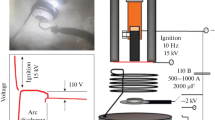Abstract
Part I of the paper discussed the temperature dependencies of the electrical resistivities, thermal conductivities, thermal diffusivities and total hemispherical emissivities of several vacuum plasma-sprayed (VPS) and cold-sprayed (CS) copper alloy monolithic coatings, VPS NiAl, VPS NiCrAlY, extruded GRCop-84 and as-cast Cu-17(wt.%)Cr-5%Al. Part II discusses the temperature dependencies of the constant-pressure specific heat capacities, C P, of these coatings. The data were empirically regression-fitted with the equation:
where T is the absolute temperature and A, B, C, D and E are regression constants. The temperature dependencies of the molar enthalpy, molar entropy and Gibbs molar free energy determined from experimental values of molar specific heat capacity are reported. Calculated values of C P using the Neumann–Kopp (NK) rule were in poor agreement with experimental data. Instead, a modification of the NK rule was found to predict values closer to the experimental data with an absolute deviation less than 6.5%. The specific molar heat capacities for all the alloys did not agree with the Dulong–Petit law, and C P > 3R, where R is the universal gas constant, were measured for all the alloys except NiAl for which C P < 3R at all temperatures.











Similar content being viewed by others
Notes
The term “monolithic coatings” is used in a generic manner in this paper to distinguish cold- and vacuum plasma-sprayed powders from cast or extruded alloys.
It is noted that the NASA polynomial equation was a better fit to the experimental data than the other commonly used empirical equation C P = E 1 + D 1*T + C 1/T 2 [7].
Although C P was used to describe the experimental data in Fig. 1, 2, 3, and 4, the term (C P)expt is used in Fig. 5, 6 and 7 specifically to distinguish the experimental data from the values calculated using Eq 2. It is noted that the experimental data shown in Fig. 5, 6 and 7 are identical to those shown in Fig. 1, 2, 3 and 4.
The deviation was defined as ((C P)NK − (C P)expt)/(C P)expt). Only absolute values are reported.
Since the specific heat measurements were not conducted between 0 and 295 K, the form of the Eq 3 has to be consistent with theories on low-temperature specific heat capacities. In the absence of experimental data, Eq 3 is provided to enable the estimation of design parameters of the RLV combustion chamber in the cryogenic range.
It should be noted that this assumption allows the calculation of the absolute values H T , S T and G T rather than ΔH T , ΔS T , and ΔG T .
References
S.V. Raj, Thermophysical Properties of Cold- and Vacuum Plasma-Sprayed Cu-Cr-X Alloys, NiAl and NiCrAlY Coatings I: Electrical and Thermal Conductivity, Thermal Diffusivity, and Total Hemispherical Emissivity, J. Mater. Eng. Perform., 2017. doi:10.1007/s11665-017-3012-0
S.V. Raj and A. Palczer, Thermal Expansion of Vacuum Plasma Sprayed Coatings, Mater. Sci. Eng. A, 2010, A527, p 2129–2135
S.V. Raj, R. Pawlik, and W. Loewenthal, Young’s Moduli of Cold and Vacuum Plasma Sprayed Metallic Coatings, Mater. Sci. Eng. A, 2009, A513-514, p 59–63
J. Karthikeyan, Development of Oxidation Resistant Coatings on GRCop-84 Substrates by Cold Spray Process, NASA CR 2007–214706, NASA Glenn Research Center, Cleveland, 2007
ASTM Standard E1269, Standard test method for determining specific heat capacity by differential scanning calorimetry, ASTM Annual Book of Standards, vol. 14.02 (ASTM International, West Conshohocken, 2004)
G.N. Lewis and M. Randall, Thermodynamics, 2nd ed., McGraw-Hill, New York, 1961, p 66
D.O. Allison, Polynomial Approximations of Thermodynamic Properties of Arbitrary Gas Mixtures Over Wide Pressure and Density Ranges, NASA TN D-6862, National Aeronautics and Space Administration, Washington, 1972
J.R. Andrews and O. Biblarz, Temperature Dependence of Gas Properties in Polynomial Form, NPS67-81-001, Naval Postgraduate School, Monterey, 1981
B.J. McBride, S. Gordon, and M.A. Reno, Coefficients for Calculating Thermodynamic and Transportation Properties of Species, NASA TM 4513, National Aeronautics and Space Administration, Washington, 1993
R. Hickman, T. McKechnie, and R. Holmes, Material Properties of Vacuum Plasma Sprayed Cu-8Cr-4Nb for Liquid Rockets, 37th Joint Propulsion Conf., Salt Lake City, UT, 2001, American Institute for Aeronautics and Astronautics, Washington, DC
Y.S. Touloukian and E.H. Buyco, Specific Heat: Metallic Elements and Alloys, Thermophysical Properties of Matter, Vol 4, IFI/Plenum, New York, 1970, p 146–152
W.S. Walston and R. Darolia, Effect of Alloying on Physical Properties of NiAl, High-Temperature Ordered Intermetallic Alloys V, (eds. I. Baker, R. Darolia, J.D. Whittenberger, and M.H. Yoo, 1993, vol. 288, p. 237–242, MRS Symposium Proceedings, Materials Research Society, Pittsburgh, PA
L.S. Darken and R.W. Gurry, Physical Chemistry of Metals, McGraw-Hill, New York, 1953
R.A. Swalin, Thermodynamics of Solids, Wiley, New York, 1962
J. Valencia and P.N. Quested, Thermophysical Properties, ASM Handbook, 2008, 15, p 468–481
J. Leitner, P. Vonka, D. Sedmidubsky, and P. Svoboda, Application of Neumann–Kopp Rule for the Estimation of Heat Capacity of Mixed Oxides, Thermochim. Acta, 2010, 497, p 1–13
R. Brandt, L. Pawlowski, G. Neuer, and P. Fauchais, Specific Heat and Thermal Conductivity of Plasma Sprayed Yttria-Stabilized Zirconia and NiAl, NiCr, NiCrAl, NiCrAlY, NiCoCrAlY Coatings, High Temp. High Press., 1986, 18, p 65–77
S.S. Zumdahl, Introductory Chemistry, 5th ed., Houghton Mifflin Co., Boston, 2004
N.F. Mott and H. Jones, The Theory of the Properties of Metals and Alloys, Dover, New York, 1958
H. Wang, R. Lück, and B. Predel, Heat Capacities of Intermetallic Compounds in the Iron-Titanium System, Z. Metall., 1993, 84, p 230–236
Acknowledgments
The experimental measurements were conducted by the Thermophysical Properties Research Laboratory, Inc. (TPRL), West Lafayette, IN under contract, and these contributions are gratefully acknowledged.
Author information
Authors and Affiliations
Corresponding author
Rights and permissions
About this article
Cite this article
Raj, S.V. Thermophysical Properties of Cold- and Vacuum Plasma-Sprayed Cu-Cr-X Alloys, NiAl and NiCrAlY Coatings II: Specific Heat Capacity. J. of Materi Eng and Perform 26, 5472–5480 (2017). https://doi.org/10.1007/s11665-017-3015-x
Received:
Published:
Issue Date:
DOI: https://doi.org/10.1007/s11665-017-3015-x




